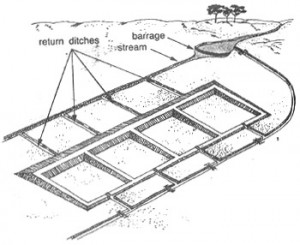The methods and fishing gear used to catch fish are a determining factor of sustainability as they can impact upon marine life and habitats. Over the past 50 years, fishing technology has advanced greatly, increasing the capacity for boats to locate and catch fish. In this time there have also been advances to reduce the environmental impact of fishing, yet there is room for further improvement and research and development is ongoing.
Fishing methods vary in different locations and cultures and the precise impacts of each method are dependent on the robustness of the management and techniques used on individual boats. The main commercial capture methods are described here to help you broadly understand the ways in which fish are caught and the environmental impacts they have.
Click on the titles in below for more information on each fishing method.
Purse Seine Net
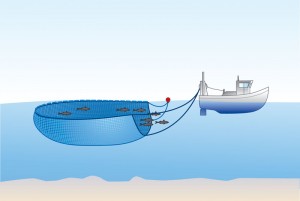 This method of fishing is used to capture large schools of fish at or near the surface. The net itself is in the shape of a long strip or wall and may be up to one kilometer in length and as deep as 200 meters. A system of weights running along the bottom and floats positioned along the top keep the net vertically suspended in the water column. Once a school of fish has been located, which is sometimes done with the help of a spotter aircraft or radar used to detect large flocks of birds feeding at the surface, the net is then pitched into the water and pulled around the school of fish to encircle it in this “wall” of netting. After the school of fish has been completely surrounded, a rope running along the top of the net, known as the purse line, is pulled to cinch the bottom closed, like a laundry bag. This conforms the net into a bowl-like shape and the school of fish is pulled on board the fishing vessel. As this technique is employed close to the surface it does come into contact with the ocean floor and therefore does not cause any damage to bottom dwelling (benthic) organisms and habitats. Bycatch is also limited due to the nets being targeted at schools of specific species of fish, however, undesired animals feeding on those schools such as sharks, dolphins, and turtles are sometimes captured. Purse seining is practiced in many commercial fisheries around the globe, and is one of the methods used to harvest Atlantic mackerel, anchovy, sardine, and Alaska salmon which are included on the KidSafe “Best Choices” seafood list. It is also used to catch fish such as bluefin and other tuna species.
This method of fishing is used to capture large schools of fish at or near the surface. The net itself is in the shape of a long strip or wall and may be up to one kilometer in length and as deep as 200 meters. A system of weights running along the bottom and floats positioned along the top keep the net vertically suspended in the water column. Once a school of fish has been located, which is sometimes done with the help of a spotter aircraft or radar used to detect large flocks of birds feeding at the surface, the net is then pitched into the water and pulled around the school of fish to encircle it in this “wall” of netting. After the school of fish has been completely surrounded, a rope running along the top of the net, known as the purse line, is pulled to cinch the bottom closed, like a laundry bag. This conforms the net into a bowl-like shape and the school of fish is pulled on board the fishing vessel. As this technique is employed close to the surface it does come into contact with the ocean floor and therefore does not cause any damage to bottom dwelling (benthic) organisms and habitats. Bycatch is also limited due to the nets being targeted at schools of specific species of fish, however, undesired animals feeding on those schools such as sharks, dolphins, and turtles are sometimes captured. Purse seining is practiced in many commercial fisheries around the globe, and is one of the methods used to harvest Atlantic mackerel, anchovy, sardine, and Alaska salmon which are included on the KidSafe “Best Choices” seafood list. It is also used to catch fish such as bluefin and other tuna species.
Trawl Net
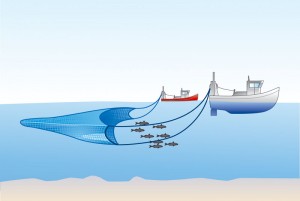 Funnel-shaped nets that are towed behind a fishing vessel through the water column at a predetermined depth, or along the seafloor. As the net travels through the water, fish are engulfed by the open mouth of the net and accumulate in the closed-off rear, called the cod end. Angled panels at either side of the mouth, called otter boards, keep each end spread apart while the net is being pulled. Floats along the top and weights or a hydrodynamic depressor along the bottom ensure that the mouth remains vertically separated. There are two major subcategories of trawling: mid-water or pelagic trawling, and bottom or benthic trawling.
Funnel-shaped nets that are towed behind a fishing vessel through the water column at a predetermined depth, or along the seafloor. As the net travels through the water, fish are engulfed by the open mouth of the net and accumulate in the closed-off rear, called the cod end. Angled panels at either side of the mouth, called otter boards, keep each end spread apart while the net is being pulled. Floats along the top and weights or a hydrodynamic depressor along the bottom ensure that the mouth remains vertically separated. There are two major subcategories of trawling: mid-water or pelagic trawling, and bottom or benthic trawling.
- Bottom trawling drags the trawl net directly along the ocean bottom. This direct contact results in a high amount of damage to benthic habitats, which are often slow to recover, or fail to recover at all.
- Mid-water trawling often employs larger nets, however, mid-water trawls do not typically come into contact with the bottom this technique causes less damage to marine habitats.
Both methods result in high rates of bycatch; particularly bottom trawls, which are notorious for harvesting large amounts of unwanted species including sea turtles and marine mammals. To combat this, the mesh-size of trawl nets used in some fisheries is regulated to permit smaller, undesired species and juvenile target species to evade capture by slipping through the netting. Devices to facilitate the escape of turtles, seals, and sea lions have also been developed. These include metal grates placed toward the rear of the net and angled toward an escape portal cut into the top or bottom. The grate allows smaller fish and crustaceans to pass through and into the cod end, while turtles or marine mammals are directed through the portal. Trawling is one of the most widely used commercial fishing methods and is practiced around the world in many different fisheries. It is one of the methods used to catch Atlantic mackerel, anchovy, and sardine which are among the species listed on the KidSafe “Best Choices” seafood list. It is also used to catch certain varieties of flounder, orange roughy, Chilean Seabass, and other species.
Gillnet
 Gillnets are long strips or walls of netting that ensnare fish by their gills once they swim into the mesh. The nets are held in a vertical position by a series of floats running along the top and weights along the bottom. Gillnets may be set in a static position with the bottom running directly along the seafloor or suspended in the middle of the water column and attached to the seafloor with anchors. Another type of gillnet, also called a driftnet, is set near the surface and is allowed to drift freely. Although a degree of selectivity is provided by the size of the mesh used, which depends on the fish species being targeted, this fishing technique is associated with high levels of bycatch. Driftnets have been responsible for catching whales, dolphins, seals, sea turtles, and seabirds, as well as undesired fish species. They may also be lost or abandoned and become “ghost nets” that can drift for months, continuing to ensnare marine life. Due to these bycatch hazards the use of driftnets has been banned in some regions, and a regulation passed by the United Nations in 1991 limits the size of driftnets that can be used to 2.5 kilometers in length. Before the U.N. ban, some driftnets were up to 60 kilometers long and 30 meters deep. Alaska salmon, which is included in the KidSafe “Best Choices” seafood list, is among the species targeted by stationary and drifting gillnets. The nets used, however, are much smaller than the driftnets employed in other fisheries and bycatch is kept to a minimum as schools of salmon are specifically targeted.
Gillnets are long strips or walls of netting that ensnare fish by their gills once they swim into the mesh. The nets are held in a vertical position by a series of floats running along the top and weights along the bottom. Gillnets may be set in a static position with the bottom running directly along the seafloor or suspended in the middle of the water column and attached to the seafloor with anchors. Another type of gillnet, also called a driftnet, is set near the surface and is allowed to drift freely. Although a degree of selectivity is provided by the size of the mesh used, which depends on the fish species being targeted, this fishing technique is associated with high levels of bycatch. Driftnets have been responsible for catching whales, dolphins, seals, sea turtles, and seabirds, as well as undesired fish species. They may also be lost or abandoned and become “ghost nets” that can drift for months, continuing to ensnare marine life. Due to these bycatch hazards the use of driftnets has been banned in some regions, and a regulation passed by the United Nations in 1991 limits the size of driftnets that can be used to 2.5 kilometers in length. Before the U.N. ban, some driftnets were up to 60 kilometers long and 30 meters deep. Alaska salmon, which is included in the KidSafe “Best Choices” seafood list, is among the species targeted by stationary and drifting gillnets. The nets used, however, are much smaller than the driftnets employed in other fisheries and bycatch is kept to a minimum as schools of salmon are specifically targeted.
Troll
 Trolling is a technique that involves a fishing vessel towing a series of lines set at different depths, depending on location of the fish being targeted. When a fish takes the bait or artificial lure, the line is reeled in and the fish brought onboard. Trolling lines do not cause much damage to marine environments, as they typically do not come into contact with the bottom. This technique also has a low bycatch rate, and any accidental catches can be released after capture. Trolling is one of the methods used to harvest wild Alaskan salmon, which is among the species on the KidSafe “Best Choices” seafood list.
Trolling is a technique that involves a fishing vessel towing a series of lines set at different depths, depending on location of the fish being targeted. When a fish takes the bait or artificial lure, the line is reeled in and the fish brought onboard. Trolling lines do not cause much damage to marine environments, as they typically do not come into contact with the bottom. This technique also has a low bycatch rate, and any accidental catches can be released after capture. Trolling is one of the methods used to harvest wild Alaskan salmon, which is among the species on the KidSafe “Best Choices” seafood list.
Longline
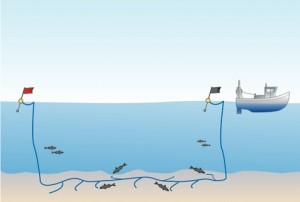 As the name suggests, a longline is composed of a mainline which may be greater than 100 kilometers in length with smaller lines suspended from it. A single long line may have well over 2000 of these smaller lines, each of which has a baited hook. As the fishing vessel moves forward, the mainline is unspooled from the sternand the baited branching lines are attached. The longline is then allowed to drift freely near the surface, or set on the bottom in some fisheries, for a pre-determined amount of time. After it has been allowed to “soak”, the longline is recovered via buoys attached to the mainline and hauled back onboard. This method of fishing causes minimal habitat damage, however, is associated with high levels of bycatch. Because of the close proximity to the surface of many longlines, seabirds and turtles are common accidental captures. Swordfish and bluefin tuna are both species targeted by longlining, and should both be avoided.
As the name suggests, a longline is composed of a mainline which may be greater than 100 kilometers in length with smaller lines suspended from it. A single long line may have well over 2000 of these smaller lines, each of which has a baited hook. As the fishing vessel moves forward, the mainline is unspooled from the sternand the baited branching lines are attached. The longline is then allowed to drift freely near the surface, or set on the bottom in some fisheries, for a pre-determined amount of time. After it has been allowed to “soak”, the longline is recovered via buoys attached to the mainline and hauled back onboard. This method of fishing causes minimal habitat damage, however, is associated with high levels of bycatch. Because of the close proximity to the surface of many longlines, seabirds and turtles are common accidental captures. Swordfish and bluefin tuna are both species targeted by longlining, and should both be avoided.
Hook and Line
 Hook and line fishing involves lowering lines with baited hooks directly from the fishing vessel. When a fish takes the bait the line is retrieved either manually or with a mechanical device and the fish is brought onboard. This method causes minimal bycatch and habitat destruction.
Hook and line fishing involves lowering lines with baited hooks directly from the fishing vessel. When a fish takes the bait the line is retrieved either manually or with a mechanical device and the fish is brought onboard. This method causes minimal bycatch and habitat destruction.
Harpoon
Harpoons are used to catch large fish swimming near the surface; swordfish and bluefin tuna are two species captured with this method. Once the fish is spotted and within range, a harpoon is thrown or thrust into the fish. A barbed point on the harpoon prevents it from being pulled out as the fish tries to swim away. Vessels fitted for harpoon fishing are equipped with an elevated superstructure to give a wider field of vision for the spotter and with a pulpit in the bow to facilitate the harpooner getting within range of their quarry. This method is highly selective and therefore does not result in bycatch, however, species like swordfish and bluefin tuna are high in mercury, and should accordingly be avoided.
Pots and Traps
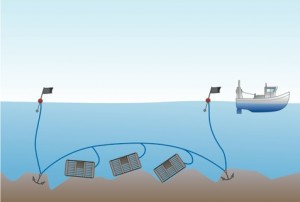 There are many different pot and trap designs, depending on the species being targeted. They are constructed of either a metal or wood frame with wire mesh or fabric netting, and have entrances that allow fish and/or crabs, lobsters, and other species in but hinder or prevent their escape. Bait is lowered to the bottom of the trap where they are allowed to sit or “soak”. After a pre-determined length of time they are located, often by an attached buoy, and pulled back onboard the fishing vessel, sometimes by hand but mostly with a mechanized winch. As the traps and pots sit on the bottom, they cause little damage to the seafloor. Bycatch associated with traps and pots is also limited.
There are many different pot and trap designs, depending on the species being targeted. They are constructed of either a metal or wood frame with wire mesh or fabric netting, and have entrances that allow fish and/or crabs, lobsters, and other species in but hinder or prevent their escape. Bait is lowered to the bottom of the trap where they are allowed to sit or “soak”. After a pre-determined length of time they are located, often by an attached buoy, and pulled back onboard the fishing vessel, sometimes by hand but mostly with a mechanized winch. As the traps and pots sit on the bottom, they cause little damage to the seafloor. Bycatch associated with traps and pots is also limited.
Various types of harvest operations raise groups of target species. There are four major types of fish farm: Open pens, ponds, raceways, and recirculating closed systems.
Open pens are placed in a near-shore ocean location or in a lake and contain fish in a large net or wire cage that is anchored to the bottom and suspended from floats at the surface in direct contact with their surrounding ecosystems. Wastewater is passed freely to the surrounding area, and disease and parasites may be passed to fish swimming in near the pen. Escapees may also compete and interbreed with wild fish, which can degrade the health of these natural populations.
Ponds are placed in tidal or inland areas and may be salt or freshwater. If the wastewater they generate is not treated, it can contaminate the surrounding ecosystem(s), and the construction of pond farms has also been the cause of habitat destruction.
Raceway farms divert water from a natural source, such as a stream, through channels where the fish are contained. The water flows through these channels and is then directed back into its original source, which can be polluted if the water coming from the farm is not properly treated. There is also the risk of fish escaping from the channels, and having harmful effects on wild fish populations.
Recirculating closed systems treat and recycle the wastewater they generate. They also leave no chance of escape, which makes them completely cut off from the surrounding environment. Most farmed arctic char, included on the KidSafe “Best Choices” seafood list, is raised in recirculating closed systems. Rainbow trout, another fish from the list, are also sustainably farmed with minimal environmental impact.
Shellfish are grown directly along the shoreline, or on trays, ropes, or bags hung from racks in shallow water close to the shore. The shellfish larvae are allowed to anchor to the structures where they mature and are then harvested. These farms do not generate waste and may even benefit nearby habitats as the shellfish they support filter the ambient water. Farmed oysters are among the species listed in the KidSafe “Best Choices” seafood list.
This content is from Good Catch, a UK project working with chefs, restaurants and caterers on seafood sustainability. SeaWeb is a partner in Good Catch
Illustrations: Julien Valo/Gcom
